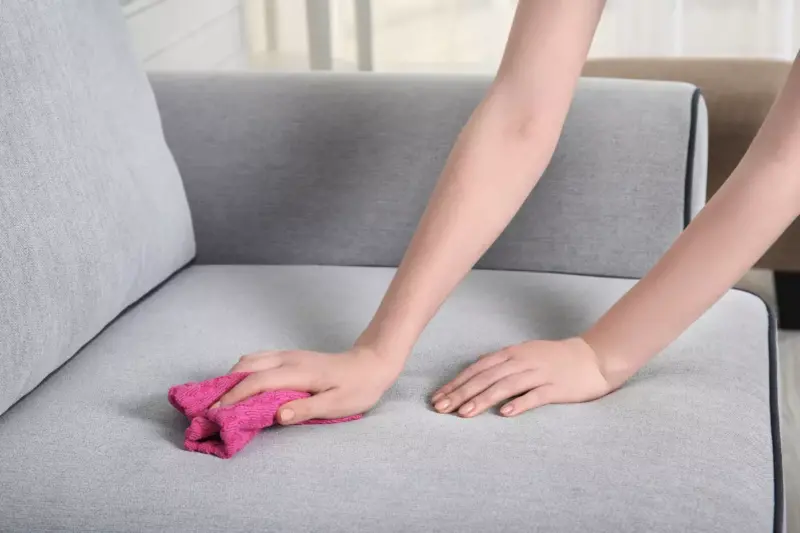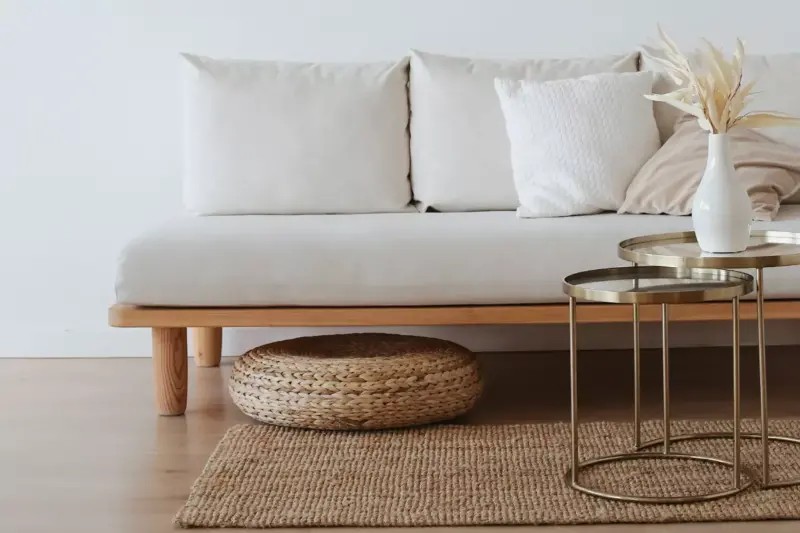
Are you faced with a stained couch and no access to a steam cleaner?
Fret not, as we’ll guide you through cleaning your beloved couch and banishing unpleasant odours, even without using a steam cleaner. You can restore your couch to its pristine state by mastering the art of how to clean a couch without a steam cleaner.
The challenge often lies in understanding the specific needs of different couch materials, from sturdy cotton to delicate silk, and employing the right cleaning methods. This guide will help you navigate these challenges, ensuring that your couch looks clean and maintains its integrity over time without needing a steam cleaner.
Couch Cleaning: Unveiling the Secrets of Spot Cleaning
Reading the Tag: The journey begins with familiarising yourself with your couch’s care instructions. The tag on your couch provides essential insights into the type of cleaning agents that can be safely used. If the tag displays a “W,” you can utilise water. For an “S,” opt for dry cleaning agents like rubbing alcohol or vinegar. When encountering “S-W,” water and dry cleaning agents are suitable. An “X” on the tag signifies vacuum cleaning exclusively.
Blotting Up Spills: Immediate attention to spills is crucial. Regardless of your couch type, swift action is needed to mop up the spill using a clean cloth or an absorbent paper towel.
Vacuuming the Couch: Ensure your couch is debris-free; leaving it unattended will make cleaning challenging. A regular vacuum cleaner is sufficient for this task, effectively removing dirt and pet hair.
Using Dish Soap: Prepare a mixture of cool water and dish soap, dampen a sponge, and gently dab at the stain. Repeating the process with fresh water and using a dry absorbent cloth to remove and sponge access water will yield effective results.
Vinegar or Alcohol for Stains: If the tag indicates “S,” utilise clear alcohol or vinegar by dipping a clean cloth and gently blotting the stain for swift removal. Also, using a dry absorbent cloth removes any residue.
Exploring Baby Wipes: Baby wipes come to the rescue for microfiber couches. Dabbing at the spill with a clean baby wipe ensures its complete removal.
Persistent Stains? Repeat the Process: Stubborn stains may require the use of a commercial cleaner or upholstery cleaner, ensuring a thorough application for optimal results.
Deep Cleaning: Elevating the Cleanliness
Before delving into deep cleaning, eliminate debris, dust, and dead skin cells from the couch’s surface.
Sprinkle Baking Soda: Separate the cushions from the couch, generously sprinkle baking soda, and let it sit for at least an hour. Extend the duration to around 12 hours for persistent odours and repeat as necessary. This is a great method, especially for pet odour.
Spot Treatments for Stubborn Stains: Treat challenging substances like blood, wine, or ink stains with a spot cleaning treatment. Apply the treatment, allow it to sit, and gently blot with a clean cloth without rubbing.
Cleaning Leather Couches with Distilled Water: Employ mild, pH-balanced soaps like Neutrogena or Dove mixed with distilled water for cleaning leather couches. Wipe the couch gently and ensure no water stains remain.
Refreshing Fabrics That Handle Water: For fabrics washable with water, create a solution by mixing liquid dish soap, white vinegar, and water. Scrub the fabric with a gentle brush with this mixture, and if the fabric allows, wash it under sunlight. Delicate fabrics may require alternative cleaning methods. Always check the tags for manufacturer care instructions.
Using a Couch Cleaner: Couch cleaners designed for water-washable fabrics are a convenient choice. Separating cushions facilitates cleaning. Carefully follow the manufacturer’s instructions, as these machines are similar to carpet cleaners.
Brushing It Back to Smoothness: After the fabrics dry, they may appear rough. Use a soft brush or lint roller to restore a smooth texture.
Caring for Non-Fabric Parts

Maintaining the non-fabric components of your couch is crucial for its overall appearance and durability. These elements, often made of wood, metal, and plastic, require specific care:
Wooden Components:
- Cleaning: Use a soft cloth dampened with a mild soap and warm water solution to gently clean wooden parts.
- Polishing: After cleaning, apply a natural wood polish or a mixture of olive oil and lemon juice to enhance the wood’s natural beauty and protect its surface.
- Protection: Regularly check for any signs of wear or damage, such as chipping or cracking, and address them promptly to prevent further deterioration.
Metal Parts:
- Rust Prevention: Ensure metal components are kept dry. Use a dry cloth to remove any moisture after cleaning.
- Rust Removal: For existing rust, apply a paste made from baking soda and lemon juice, let it sit for a few minutes, and then gently scrub it off.
- Regular Checks: Inspect for loose screws or fittings and tighten them to ensure structural integrity.
Plastic Elements:
- Simple Cleaning: Wipe down with a cloth soaked in a soapy water solution. This method is usually sufficient for most plastic parts.
- Avoiding Damage: Be cautious with harsh chemicals or abrasive materials that can damage the plastic’s surface.
- Drying: Always dry thoroughly to avoid water spots or streaks for a clean, polished look.
Get Your Obligation FREE Quote Now!
How To Clean Cushion Covers
Properly cleaning cushion covers is essential for maintaining your couch’s fresh look and feel. When it’s time to wash them, it’s advisable to handle only 4-5 covers at a time to avoid overcrowding in the washing machine, which ensures a thorough cleaning.
Before washing, check the care labels for specific water temperature, cycle type, and detergent suitability instructions. Opt for a mild detergent that’s gentle on fabrics to preserve the colour and texture of the covers.
For drying, either air dry or use a tumble dryer on a low heat setting, as per the manufacturer’s guidelines. If the covers are prone to wrinkles, remove them slightly damp and iron them on a low heat setting.
This careful approach keeps your cushion covers looking their best and extends their lifespan, contributing to the overall appearance and comfort of your couch.
Conclusion
In summary, maintaining a clean and inviting couch is achievable with the right techniques and a bit of effort. From spot cleaning to taking care of cushion covers, each step plays a crucial role in preserving the beauty and comfort of your furniture. However, for those tough stains or when you require a deeper cleaning, don’t hesitate to reach out to a professional upholstery cleaner. Contact our expert upholstery cleaners today and give your couch the care it deserves!

Terry is a professional carpet cleaner with over a decade of experience. He’s passionate about using eco-friendly products to provide a clean and safe home for his clients. With a keen eye for detail, Terry tailors his services to meet his clients’ unique needs. He values transparency and excellent customer service, ensuring his clients are satisfied with the results.



